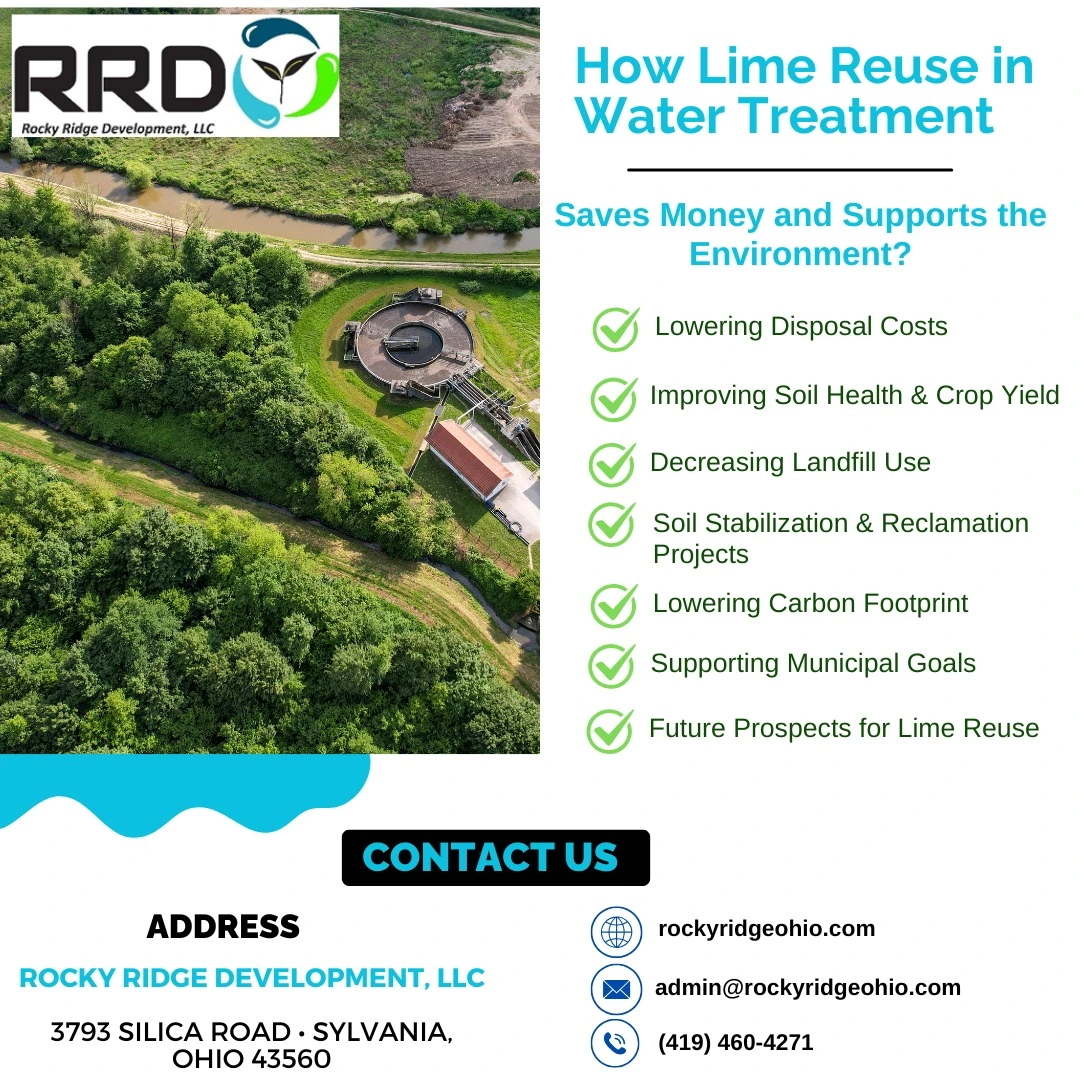

Lime reuse in water treatment offers economic and environmental benefits by converting a by-product into a valuable resource. When used in drinking water treatment, lime helps remove impurities and produce a clean, safe water supply. Instead of discarding the residual lime, companies like Rocky Ridge Development repurpose it, particularly for agricultural and soil improvement applications. Reusing lime reduces landfill waste, enhances soil health, supports sustainable agriculture, and cuts costs associated with waste disposal. This circular approach aligns with environmental stewardship, helping to lower carbon footprints and preserve resources.

Water treatment facilities often use lime to remove impurities, balance water pH levels, and reduce the presence of harmful chemicals or heavy metals. Lime, when added to water, binds with particles and contaminants, facilitating their removal. The process results in a by-product—water treatment lime residuals, or lime sludge—which was traditionally discarded in landfills. However, forward-thinking approaches have led to the reuse of these lime materials, presenting significant economic and environmental advantages.
Let’s delve into how lime reuse supports sustainable practices, benefits agriculture, and reduces costs in the water treatment sector.
One of the biggest economic advantages of lime reuse in water treatment is the cost savings in waste disposal. Previously, disposing of lime sludge in landfills was costly for treatment facilities, as they had to pay for the transportation and landfill fees. By finding alternative uses for lime, such as in soil enhancement or construction applications, these facilities eliminate a portion of their disposal expenses, passing savings on to municipalities and customers.
Agricultural stakeholders can further benefit by purchasing this repurposed lime at a lower cost than other soil amendments. This repurposed lime is applied directly to farmland, providing a cost-effective solution to maintain crop yield and soil quality.
Repurposed lime has become a valuable asset in agriculture. The lime residuals help neutralize acidic soils, making them more suitable for crop growth. High soil acidity is a common issue that affects crop health, reducing yield and crop quality. By incorporating treated lime into soils, farmers can improve soil structure, increase nutrient availability, and raise crop productivity. This soil-enhancement solution is more affordable and environmentally friendly than chemical fertilizers or other soil amendments.
This synergy between water treatment facilities and agricultural stakeholders is particularly advantageous in areas with acid-prone soils. The residual lime not only corrects pH levels but also enriches the soil with calcium, an essential mineral for plant growth. This supports the plant’s ability to absorb other nutrients, ensuring a more balanced soil profile and healthier crops.
When lime sludge is disposed of in landfills, it can lead to environmental concerns, including the leaching of substances into surrounding ecosystems. Lime sludge may take years to break down in a landfill environment, leading to longer-term environmental impacts. By finding new applications for lime residuals, water treatment facilities play a part in promoting a circular economy, where waste products are continuously reused rather than discarded.
Repurposing lime mitigates the environmental burden of landfills and reduces greenhouse gas emissions associated with transporting waste. In a circular model, lime serves multiple functions before it’s considered waste. Companies like Rocky Ridge Development, which specialize in beneficial reuse solutions, play an integral role by connecting water treatment by-products with end-users like farmers or construction projects, transforming a potential environmental issue into a resource.
Beyond agriculture, lime residuals are also useful in soil stabilization, making them ideal for construction and land reclamation projects. Lime-treated soils are more stable and less prone to shifting, making them a solid foundation for infrastructure. This is particularly valuable in areas with soft or moist soil that would otherwise be challenging for construction. The calcium carbonate in lime reacts with soil particles, increasing compaction and stability, which can prevent erosion and improve soil resilience in construction projects.
Reclamation projects can further benefit from lime’s ability to bind contaminants and stabilize soils. Mining sites, for example, can incorporate lime to rehabilitate areas affected by acidic drainage or erosion, promoting healthier land recovery.
Reusing lime in agriculture and construction not only promotes environmental sustainability but also reduces the need for new raw materials, conserving resources and decreasing carbon emissions linked to lime mining and production. By replacing raw lime with water treatment residuals, we reduce the demand for freshly mined materials, cutting down the energy and emissions involved in its extraction and processing.
Incorporating lime reuse into municipal or corporate sustainability goals directly supports environmental sustainability objectives and can also contribute to a lower overall carbon footprint. This practice aligns with environmental, social, and governance (ESG) standards, offering organizations a chance to showcase their commitment to eco-friendly solutions while achieving measurable environmental impact reductions.
Municipal water treatment facilities and local governments are increasingly responsible for meeting strict environmental regulations. By implementing lime reuse programs, these entities can comply with landfill reduction mandates and other sustainability-related regulations. Furthermore, these practices reflect positively on municipalities, showcasing their commitment to resource stewardship and green initiatives. Partnering with companies that specialize in reusing waste materials not only helps municipalities achieve compliance but also supports their sustainability goals.
While lime reuse in water treatment offers various benefits, there are still challenges in scaling and expanding this practice. Not all lime by-products have the same chemical composition, meaning treatment and testing are required to ensure they meet safety standards for agriculture or construction uses. Additionally, transportation and application of lime in agricultural fields can vary in effectiveness based on regional needs and soil types.
However, advancements in treatment technologies are helping overcome these hurdles, making lime reuse more accessible. As environmental awareness and sustainability requirements grow, lime reuse programs are likely to expand, driven by innovative companies and municipalities committed to sustainable development.
The reuse of lime in water treatment provides a sustainable solution that supports environmental health, economic savings, and resource conservation. By embracing circular economy practices, water treatment facilities, agricultural stakeholders, and local governments can reduce waste, lower costs, and help build a greener, more sustainable future. As demand for eco-friendly practices increases, lime reuse stands as an example of how industry and environmental goals can align to foster responsible resource management.
In an age where sustainability is a growing priority, lime reuse is a shining example of practical environmental stewardship, creating a ripple effect that benefits communities, industries, and the environment at large.